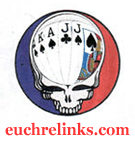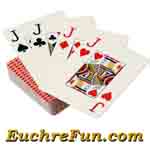
|
| « Games Index | History of Playing Cards | Early Standards | Gallery of Playing Cards | Card Backs |
Canasta
Canasta, a game of the Rummy family, was the most popular card game in America in the 1950s. It originated in Uraguay 10 years earlier, spread rapidly through Argentina and the rest of Latin America, and reached the United States in 1948. The word, “canasta”, means “basket” in Spanish. The game has given rise to a number of variations including Samba, Bolivia, and Chile.
Number of Players
Four players in two fixed-partnerships. Canasta can also be adapted to 2, 3, 5 and 6 players. Partners sit opposite each other.
The Cards
Two standard decks of 52 cards, plus 4 Jokers, giving a total of 108 cards.
Wild Cards
Jokers and 2’s are wild and may be used to assume the identity of a particular card in order to complete a meld.
The Deal
Deal and play are clockwise. The deal proceeds to the left at the end of each hand. Each player is dealt 11 cards.
The undealt portion of the deck remain face down in the middle of the table and forms the stock.
The top card is turned face up, and placed beside the stock. If it is a Joker or a Two, one or more additional cards must be turned until a ‘natural’ card appears.
The Play
Starting left of the dealer, each player in turn normally first
- Draws a card from the stock, then
- Melds and/or lays off cards, as many as they so choose
- Discards a card face up to the discard pile to complete the turn.
Red Threes
A player finding a red 3 in his/her hand must, on their first turn, put it face up on the table and draw a replacement from the stock.
A player who draws a red 3 from the stock must also lay it face up on the table and draw a replacement from the stock. Finally, a player who takes the discard pile and finds a red 3 in it must place the red 3 face up on the table but does not draw a replacement.
Each red 3 has a bonus value of 100 points, but if one side has all four red 3s, they count as 200 each i.e. 800 in all. The value of the red 3s is credited to a side that has made a meld or debited against a side that has made no meld, when the hand ends.
Objective
The principal objective of play is to make melds combining three or more cards of the same rank. Sequences don’t count in Canasta and for this reason Samba is probably a more enjoyable game.
A meld is valid if it contains at least two natural cards and not more than three wild cards. Jokers and Deuces may not be melded apart from natural cards.
A set of Black 3s may only be melded (without wild cards) only when a player goes out.
At the end of the hand, all the cards and melds a partnership has are counted to their score, while all the cards left in hand count against their score. All the cards left in a player’s hand when play ends, even if they may form melds, count their value as minus.
A player may meld as many cards as they please, of one rank or different ranks, forming new melds or adding cards to existing melds.
A player may add additional cards to a meld made by his own side, but may not add any cards to their opponent’s melds.
Canastas
A meld comprising seven or more cards, including at least four natural cards, is a canasta. In addition to the point value of the cards, a canasta earns a bonus of 500 for a ‘natural’ or ‘pure’ canasta, and 300 for a ‘mixed’ canasta (one containing wild cards).
A complete canasta is squared up with a red card on top to indicate a ‘natural’ or a black card on top to indicate a ‘mixed’ canasta.
Minimum Count
Every card has a fixed point value
Each Joker = 50
Each Deuce = 20
Each Ace = 20
Each K, Q, J, 10, 9, 8 = 10
Each 7, 6, 5 4 = 5
Each Black 3 = 5
A partnership’s first meld must meet minimum count requirement that depends on the accumulated score of that side at the time.
Score |
Minimum Initial Meld |
Minus |
15 points |
0 - 1495 |
50 points |
1500 - 2995 |
90 points |
3000 + |
120 points |
The count of a meld is the total point value of the cards in it. To meet the minimum, a player may make two or more different melds. Bonuses of red threes and canastas do not count toward the minimum.
After a side has made its initial meld, either partner my make any valid meld without reference to any minimum count.
Taking the Discard Pile
When the discard pile is not frozen against his/her side a player may take it
- with a natural pair matching the top card
- by melding the top card
- by adding the top card to a meld he/she already has on the table.
Having melded the top discard, the player takes the rest of the pile into his hand and may then meld some or all of the additional cards as he/she pleases. The player discards one card to the discard pile to complete their turn.
The discard pile may never be taken when its top card is a wild card, a black 3 or a red 3.
Freezing the Discard Pile
The discard pile is frozen when
- To either side that has not made a meld
- To both sides if it contains a wild card. That would mean that either one was turned up at the deal, or someone discarded a Deuce or a Joker to the pile.
- When the upcard is a black 3. Well, technically, that means the pack is ‘stopped’ because you can’t meld a black 3 with anything, so you can’t pick up the pack. However, once that player discards, the pack is effectively ‘unstopped’, and the next player in turn could take up the discard pile, providing they had matching cards in hand.
When the discard pile is frozen the player in turn may only take the discard pile if they can make a new meld by taking the upcard and melding it with at least two natural cards from their hand.
Such a meld, however, must meet the minimum requirements if the side has not made an initial meld.
The discard pile is frozen when a red 3 is turned as an upcard or if a wild card or a black 3 is turned as an upcard or discarded.
Unfreezing the Discard Pile
A frozen discard pile is unfrozen only by being taken. When the discard pile is topped by a wild card or black 3, at least one natural card must be discarded on top before the pile can be taken. Then a player make take that card and the pile only when a natural pair of the same rank from his hand. Before touching the discard pile, the player should show the pair, together with any additional cards needed to meet the minimum count needed for the initial meld.
Going Out
A player goes out when he gets rid of the last card in his hand by discarding or melding it, provided that their side has melded at least one canasta or he completes a canasta while going out. Failing this requirement, he must keep at least one card in his hand. When a player goes out, the hand ends and the results on both sides are scored.
A player need not make a discard in going out; he/she may meld all of his remaining cards.
A player with only one card left in his hand may not take the discard pile if there is only one card in it.
Permission to Go Out
If a player sees that he/she is able to go out, before or after drawing, the player may ask their partner who must answer “yes” or “no”, and the answer is binding. However, the player may go out without asking permission.
Concealed Hand
A player goes out ‘concealed’ when he/she melds his entire hand in one turn, including at least one canasta, without having made a meld or having added any cards to his/her partner’s melds. If his/her partner has not made an initial meld, the player must meet the minimum count (without the canasta bonus) if he/she has taken from the discard pile, but need not do so if he/she has drawn from the stock.
Exhausting the Stock
If no one has gone out by the time the last card is drawn from the stock then each player in turn takes the discard of the previous player in turn, and must do so, so long as it matches a meld of his partnership; or may choose to take such a discard if he can use it to form a new meld – but does not have to take it. Play ends when either a player cannot take up the discard, or the player legally refuses to do so.
Note, that if the last card of the stock happens to be a Red 3, the player reveals it. In this case, the player may not meld or discard. Play simply ends.
Scoring a Deal
At the end of the hand, each partnership tallies their score by scoring both for all their melds, plus the face value of the individual cards making up the melds, and minus any cards left in hand. The value of Red 3s is credited to a team that has made a meld, but debited against that team if they have not made a meld.
|
|
||||||||||||||||||||||||||||
Game
Canasta is played over a number of hand to a grand total of 5000 points.
L I N K S
Canasta Rules - Rummy-Games.com
How to play Canasta - Cats at Cards
Canasta - Card Games Heaven
Rules for Canasta - Card Games Website
| Complete Index of Card Games » |
|||||||||||||||
|
|||||||||||||||
|
|||||||||||||||
| |||||||||||||||
| |||||||||||||||
|
|||||||||||||||
| |||||||||||||||
|
|||||||||||||||
| |||||||||||||||
|
|||||||||||||||
| Complete Index of Card Games » |


| « Games Index | History of Playing Cards | Early Standards | Gallery of Playing Cards | Card Backs |

|
|
|